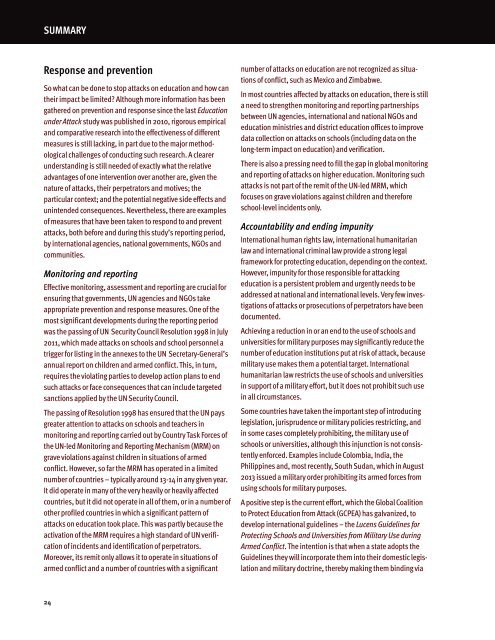You also want an ePaper? Increase the reach of your titles
YUMPU automatically turns print PDFs into web optimized ePapers that Google loves.
SUMMARY<br />
Response and prevention<br />
So what can be done to stop attacks on education and how can<br />
their impact be limited? Although more information has been<br />
gathered on prevention and response since the last Education<br />
under Attack study was published in 2010, rigorous empirical<br />
and comparative research into the effectiveness of different<br />
measures is still lacking, in part due to the major methodological<br />
challenges of conducting such research. A clearer<br />
understanding is still needed of exactly what the relative<br />
advantages of one intervention over another are, given the<br />
nature of attacks, their perpetrators and motives; the<br />
particular context; and the potential negative side effects and<br />
unintended consequences. Nevertheless, there are examples<br />
of measures that have been taken to respond to and prevent<br />
attacks, both before and during this study’s reporting period,<br />
by international agencies, national governments, NGOs and<br />
communities.<br />
Monitoring and reporting<br />
Effective monitoring, assessment and reporting are crucial for<br />
ensuring that governments, UN agencies and NGOs take<br />
appropriate prevention and response measures. One of the<br />
most significant developments during the reporting period<br />
was the passing of UN Security Council Resolution 1998 in July<br />
2011, which made attacks on schools and school personnel a<br />
trigger for listing in the annexes to the UN Secretary-General’s<br />
annual report on children and armed conflict. This, in turn,<br />
requires the violating parties to develop action plans to end<br />
such attacks or face consequences that can include targeted<br />
sanctions applied by the UN Security Council.<br />
The passing of Resolution 1998 has ensured that the UN pays<br />
greater attention to attacks on schools and teachers in<br />
monitoring and reporting carried out by Country Task Forces of<br />
the UN-led Monitoring and Reporting Mechanism (MRM) on<br />
grave violations against children in situations of armed<br />
conflict. However, so far the MRM has operated in a limited<br />
number of countries – typically around 13-14 in any given year.<br />
It did operate in many of the very heavily or heavily affected<br />
countries, but it did not operate in all of them, or in a number of<br />
other profiled countries in which a significant pattern of<br />
attacks on education took place. This was partly because the<br />
activation of the MRM requires a high standard of UN verification<br />
of incidents and identification of perpetrators.<br />
Moreover, its remit only allows it to operate in situations of<br />
armed conflict and a number of countries with a significant<br />
number of attacks on education are not recognized as situations<br />
of conflict, such as Mexico and Zimbabwe.<br />
In most countries affected by attacks on education, there is still<br />
a need to strengthen monitoring and reporting partnerships<br />
between UN agencies, international and national NGOs and<br />
education ministries and district education offices to improve<br />
data collection on attacks on schools (including data on the<br />
long-term impact on education) and verification.<br />
There is also a pressing need to fill the gap in global monitoring<br />
and reporting of attacks on higher education. Monitoring such<br />
attacks is not part of the remit of the UN-led MRM, which<br />
focuses on grave violations against children and therefore<br />
school-level incidents only.<br />
Accountability and ending impunity<br />
International human rights law, international humanitarian<br />
law and international criminal law provide a strong legal<br />
framework for protecting education, depending on the context.<br />
However, impunity for those responsible for attacking<br />
education is a persistent problem and urgently needs to be<br />
addressed at national and international levels. Very few investigations<br />
of attacks or prosecutions of perpetrators have been<br />
documented.<br />
Achieving a reduction in or an end to the use of schools and<br />
universities for military purposes may significantly reduce the<br />
number of education institutions put at risk of attack, because<br />
military use makes them a potential target. International<br />
humanitarian law restricts the use of schools and universities<br />
in support of a military effort, but it does not prohibit such use<br />
in all circumstances.<br />
Some countries have taken the important step of introducing<br />
legislation, jurisprudence or military policies restricting, and<br />
in some cases completely prohibiting, the military use of<br />
schools or universities, although this injunction is not consistently<br />
enforced. Examples include Colombia, India, the<br />
Philippines and, most recently, South Sudan, which in August<br />
2013 issued a military order prohibiting its armed forces from<br />
using schools for military purposes.<br />
A positive step is the current effort, which the Global Coalition<br />
to Protect Education from Attack (GCPEA) has galvanized, to<br />
develop international guidelines – the Lucens Guidelines for<br />
Protecting Schools and Universities from Military Use during<br />
Armed Conflict. The intention is that when a state adopts the<br />
Guidelines they will incorporate them into their domestic legislation<br />
and military doctrine, thereby making them binding via<br />
24


